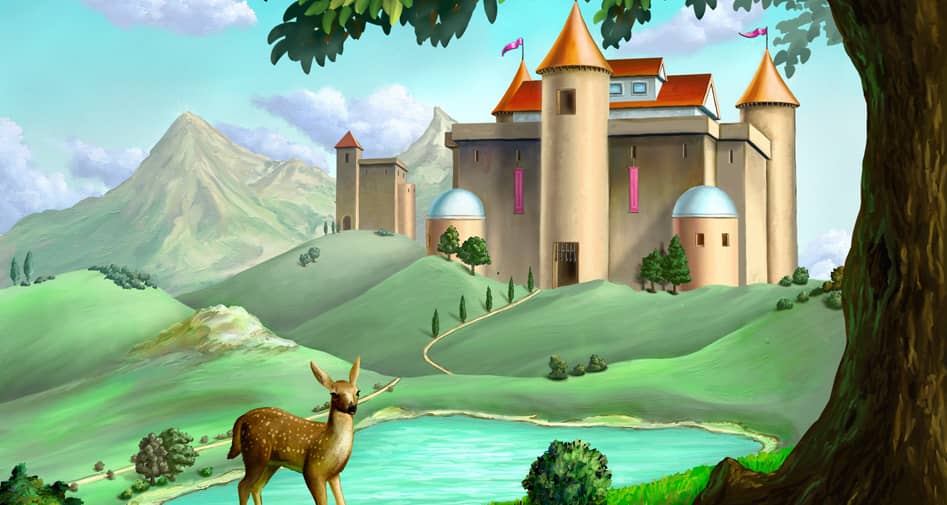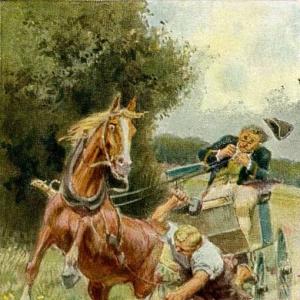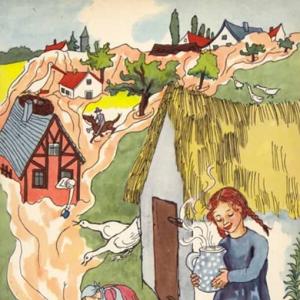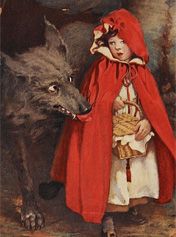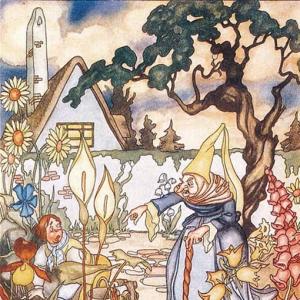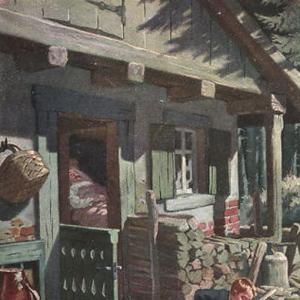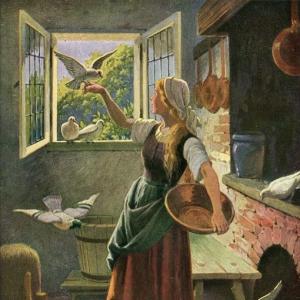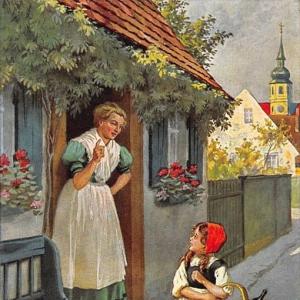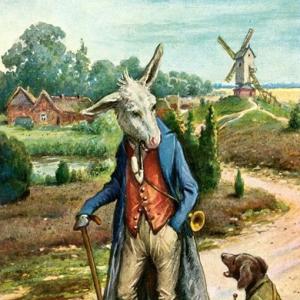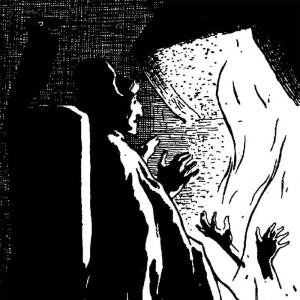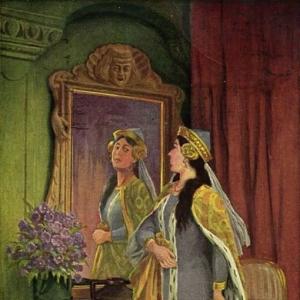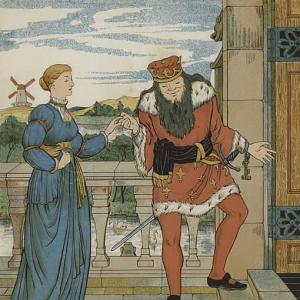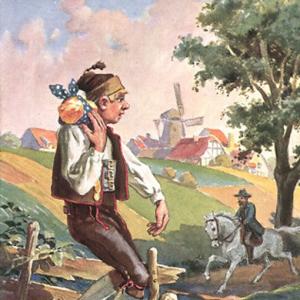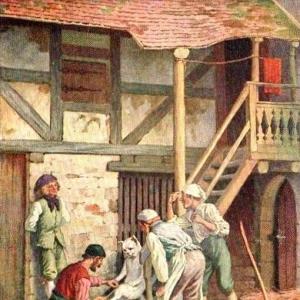Reading time for children: 4 min
A little brother and sister were once playing by a well, and while they were thus playing, they both fell in. A water-nix lived down below, who said, „Now I have got you, now you shall work hard for me!“ and carried them off with her. She gave the girl dirty tangled flax to spin, and she had to fetch water in a bucket with a hole in it, and the boy had to hew down a tree with a blunt axe, and they got nothing to eat but dumplings as hard as stones. Then at last the children became so impatient, that they waited until one Sunday, when the nix was at church, and ran away. But when church was over, the nix saw that the birds were flown, and followed them with great strides. The children saw her from afar, and the girl threw a brush behind her which formed an immense hill of bristles, with thousands and thousands of spikes, over which the nix was forced to scramble with great difficulty; at last, however, she got over. When the children saw this, the boy threw behind him a comb which made a great hill of combs with a thousand times a thousand teeth, but the nix managed to keep herself steady on them, and at last crossed over that. Then the girl threw behind her a looking-glass which formed a hill of mirrors, and was so slippery that it was impossible for the nix to cross it. Then she thought, „I will go home quickly and fetch my axe, and cut the hill of glass in half.“ Long before she returned, however, and had hewn through the glass, the children had escaped to a great distance, and the water-nix was obliged to betake herself to her well again.
 Learn languages. Double-tap on a word.Learn languages in context with Childstories.org and Deepl.com.
Learn languages. Double-tap on a word.Learn languages in context with Childstories.org and Deepl.com.Backgrounds
Interpretations
Adaptions
Summary
Linguistics
„The Water Nixie“ is a lesser-known fairy tale collected by the Brothers Grimm, Jacob (1785-1863) and Wilhelm (1786-1859) Grimm, who were German academics, linguists, cultural researchers, and authors. They are best known for their collection of folktales, which they started compiling in the early 19th century. Their work, „Children’s and Household Tales“ („Kinder- und Hausmärchen“), was published in 1812 and went through multiple editions and revisions over the years.
The Brothers Grimm collected and preserved traditional stories from various sources, including oral traditions and written texts. Their aim was to document and preserve the cultural heritage of the German-speaking people. They were part of the Romantic movement in literature, which emphasized the importance of folklore and the natural world as sources of inspiration.
The water nixie or nix is a mythological creature found in European folklore, particularly in Germanic and Scandinavian traditions. It is a water spirit or supernatural being that is often associated with rivers, lakes, or wells. These beings can be either malevolent or benevolent, depending on the specific tale. In „The Water Nixie,“ the creature is portrayed as an antagonist who enslaves the children and forces them to endure hardship.
While „The Water Nixie“ may not be as well-known as some of the Grimm Brothers‘ other stories, it shares common themes and motifs with their broader body of work, such as the struggle between good and evil, the importance of family, and the resourcefulness of children.
„The Water Nixie“ offers various interpretations and themes.
The Struggle for Freedom: The story demonstrates the importance of personal freedom and the willingness to fight for it. The children’s determination to escape the nix’s control is a testament to their resilience and courage in the face of adversity.
Overcoming Obstacles: The children use their resourcefulness to create barriers that slow down the nix. This theme emphasizes the idea that, with clever thinking and determination, one can overcome obstacles and achieve their goals.
The Power of Cooperation: The brother and sister work together to evade the nix. Their collaborative efforts and trust in one another prove to be the key to their successful escape. This theme highlights the value of teamwork and the bonds of family.
The Duality of Good and Evil: The tale showcases the struggle between the innocent children and the malicious water nix. It highlights the contrast between the pure intentions of the children and the malevolent nature of the nix, emphasizing the age-old battle between good and evil.
The Resourcefulness of Youth: The children’s ability to outwit the nix despite their young age and limited resources illustrates the potential for resourcefulness and intelligence in young people. This theme encourages readers to never underestimate the power of a child’s imagination and problem-solving skills.
The Importance of Persistence: Throughout the story, the children face various challenges but never give up on their quest for freedom. This theme underscores the importance of perseverance in overcoming difficult situations and the value of staying true to one’s goals.
„The Water Nixie“ is a popular fairy tale that has been adapted into various forms of media over the years. Here are some notable adaptations:
Operas: Several operas have been based on the story of „The Water Nixie,“ including Dvořák’s „Rusalka“ and Tchaikovsky’s „Undine.“
Films: There have been several film adaptations of the story, including the 1920 silent film „The Water Nixie“ and the 1954 West German film „The Water Nixie of the Rhine.“
Television: The story has also been adapted for television, including a 1982 episode of the British TV series „Faerie Tale Theater“ and a 1993 episode of the Japanese anime series „Mermaid’s Forest.“
Literature: „The Water Nixie“ has been retold and reimagined in various works of literature, including Patricia C. Wrede’s young adult novel „The Enchanted Forest Chronicles“ and Diana Wynne Jones‘ novel „Fire and Hemlock.“
Music: The story has also inspired various musical works, including the song „The Water Nixie“ by Swedish folk rock band Garmarna and the song „Undine“ by German band In Extremo.
These adaptations often put their own spin on the original story, exploring different themes and adding their own creative elements.
„The Water Nixie“ is a Brothers Grimm fairy tale that tells the story of a little brother and sister who accidentally fall into a well while playing. They are captured by a water-nix, a water spirit, who forces them to work for her. The girl is tasked with spinning dirty, tangled flax, fetching water in a leaky bucket, while the boy must cut down a tree with a blunt axe. Their food consists only of hard, stone-like dumplings.
Tired of their harsh life, the children decide to escape one Sunday when the nix is attending church. When the nix realizes the children have fled, she pursues them with giant strides. The children use magical objects to slow her down. The girl throws a brush behind her, creating a massive, spiked hill that the nix struggles to climb over. The boy then throws a comb, forming a vast hill of combs with countless teeth, which the nix laboriously crosses. Finally, the girl throws a looking-glass, creating a slippery hill of mirrors that the nix cannot cross.
Desperate, the nix returns home to fetch her axe to cut through the glass hill. By the time she breaks through, the children have already reached a safe distance. Defeated, the water nix returns to her well, while the brother and sister are free from her clutches.
The fairy tale „The Water Nixie“ by the Brothers Grimm can be examined linguistically through its narrative structure, language features, and thematic elements.
Here’s a linguistic analysis focusing on these aspects:
Narrative Structure
Exposition: The story begins with a brief setup where the siblings are introduced playing by a well. This opening serves to quickly establish the characters and the setting.
Rising Action: The tension escalates when the children fall into the well and are captured by the water nixie, forced to perform impossible tasks, setting the stage for their eventual escape.
Climax: The climax occurs as the children make their escape using magical items to delay the nixie. Each item they throw behind transforms into an obstacle for the nixie, increasing the pace and tension.
Falling Action and Resolution: The story resolves with the children’s successful escape and the nixie’s inability to recapture them, ending with a return to equilibrium where the water nixie is left frustrated.
Language Features
Dialogue and Direct Speech: The direct speech of the water nixie („Now I have got you, now you shall work hard for me!“) adds immediacy and characterizes the nixie as demanding and authoritative.
Repetition and Parallelism: The narrative employs repetition and parallel structure, particularly in the sequence where the children throw items behind them to thwart the nixie. This repetition emphasizes the children’s resourcefulness and the magical nature of their escape tools.
Descriptive Language and Imagery: The tale uses vivid descriptive language, such as „dirty tangled flax,“ „bucket with a hole,“ and „hill of mirrors,“ to create strong visual images, illustrating the arduous tasks the children face and the enchanted obstacles they create.
Simple Syntax: The use of simple sentence structures makes the story accessible to a younger audience, maintaining a straightforward and engaging narrative flow.
Thematic Elements
Ingenuity and Resourcefulness: The children’s use of magical objects to escape highlights themes of cleverness and the triumph of wit over adversity.
Persistence in Adversity: Despite the difficult tasks and the relentless pursuit by the nixie, the children’s persistence is a central theme, demonstrating resilience.
Good vs. Evil: The tale follows a traditional fairy tale motif of innocent protagonists against a malevolent force, here represented by the water nixie, echoing themes of good triumphing over evil.
Escape and Freedom: The central narrative drive is the children’s desire to escape servitude, reflecting broader themes of the quest for freedom and the return to safety.
Overall, „The Water Nixie“ employs typical fairy tale linguistic and thematic elements to create an engaging narrative that underlines themes of ingenuity, persistence, and the triumph of good over evil. Through its simple yet evocative language, the story captures the imagination while conveying moral lessons.
Information for scientific analysis
Fairy tale statistics | Value |
|---|---|
| Number | KHM 79 |
| Aarne-Thompson-Uther-Index | ATU Typ 313 |
| Translations | DE, EN, DA, ES, PT, IT, JA, NL, PL, RU, TR, TR, VI, ZH |
| Readability Index by Björnsson | 40.5 |
| Flesch-Reading-Ease Index | 74.4 |
| Flesch–Kincaid Grade-Level | 9.7 |
| Gunning Fog Index | 12.1 |
| Coleman–Liau Index | 7.8 |
| SMOG Index | 8.1 |
| Automated Readability Index | 11.3 |
| Character Count | 1.573 |
| Letter Count | 1.220 |
| Sentence Count | 11 |
| Word Count | 304 |
| Average Words per Sentence | 27,64 |
| Words with more than 6 letters | 39 |
| Percentage of long words | 12.8% |
| Number of Syllables | 375 |
| Average Syllables per Word | 1,23 |
| Words with three Syllables | 8 |
| Percentage Words with three Syllables | 2.6% |
